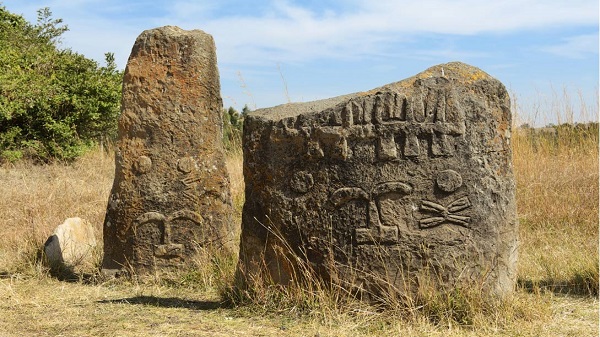
(Selamta Magazine)–Ethiopia boasts a wide-ranging set of scenes and sights, including nine UNESCO-inscribed ‘world heritage sites’.
In 2016, Ethiopia earned a new moniker: “The Land of Origins.” The nickname — which serves as Ethiopia’s official tourism motto — emphasizes the country’s long and rich history, staking its claim as the source of humankind (the earliest remains of our human ancestors were found here); the birthplace of the premier wild coffee plant known as Arabica; and the beginning of the Blue Nile, earth’s longest river. And that’s just for starters.
Indeed, with countless ancient churches and monasteries, remains of palatial complexes and medieval forts, and wildly varying (but all astounding) landscapes, Ethiopia offers plenty of sights and scenery for travelers of every ilk. Thousands of its heritage sites have been registered at the national level, while 9 have made it to UNESCO’s prestigious World Heritage Site list — the largest number for any African country.
◌ ALSO: Ethiopia Elected as UNESCO Executive Board Member
Here, we provide an introductory glimpse of those Ethiopian giants to receive UNESCO’s recognition under ‘World Heritage Sites’, beginning with Simien Mountains National Park; as one of the original 12 sites honored with the designation back in 1978, the park feels like a fitting starting point to showcase the natural and cultural wonders of the Land of Origins.
UNESCO World Heritage Sites in Ethiopia
Simien National Park
Date of Inscription: 1978
Region: Amhara
The first of Ethiopia’s sites to be deemed UNESCO-worthy, Simien Mountains National Park presents a seemingly unending array of rugged gorges and jagged cliffs, including the highest peak in the country, Ras Dashen. Many endangered species, such as the walia ibex (Ethiopian mountain goat), the gelada baboon and the Ethiopian wolf, also call this area home.
Rock-Hewn Churches, Lalibela
Date of Inscription: 1978
Region: Amhara
Said to have been built in the 13th-century with the help of angels, this “New Jerusalem” attributed to King Lalibela is the homeland of Ethiopian Christianity, with 11 churches astoundingly carved from the rock.
Fasil Ghebbi, Gondar
Date of Inscription: 1979
Region: Amhara
Known as the “Camelot of Africa,” the fortified city of Fasil Ghebbi was built over the course of several centuries. Emperor Fasiledes began the work in 1636 after dubbing Gondar Ethiopia’s capital and starting to build the first castle, and many of the emperors who succeeded him left their own structural signatures — creating, in effect, the Baroque royal compound we know today.
Lower Valley of the Omo
Date of Inscription: 1980
Region: Southern Nations, Nationalities and Peoples
The sedimentary deposits of this southwestern valley are now world-famous, having contained countless hominid fossils and ancient tools that date as far back as 3.5 million years. The area also continues to foster many thriving and varied cultures that call it home.
Aksum
Date of Inscription: 1980
Region: Tigrai
Located in the northern Ethiopian Highlands, Aksum once stood as the most powerful state between the Eastern Roman Empire and Persia. The ruins that remain, dating from between the 1st and 13th centuries, range from giant obelisks to royal tombs and ancient castles. According to Ethiopian tradition, a church in Aksum is also believed to hold the biblical Ark of the Covenant.
Lower Valley of the Awash
Date of Inscription: 1980
Region: Afar
In 1974, paleontologists discovered Lucy — the famous 3.2-million-year-old hominid — amid this ancient paleo-anthropological site. The Awash valley remains significant as one of the most important groupings of such sites on the African continent, lending numerous contributions to the understanding of the history of human development.
Tiya
Date of Inscription: 1980
Region: Southern Nations, Nationalities and Peoples
Thirty-six prehistoric rock art monuments from an unknown ancient civilization dot this central Ethiopian site, located south of Addis Ababa.
Harar Jugol, the Fortified Historic Town
Date of Inscription: 2006
Region: Harari
Considered the fourth most-sacred Muslim city, Harar Jugol is a maze-like fortified town whose walls date back to between the 13th and 16th centuries. The Harar Kingdom, however, was founded in 940 A.D. by Sheikh Aw Abadir and other saints, who together oversaw the building of 99 mosques according to the 99 names of God referred to in the Quran; of those, an estimated 82 remain in Harar today.
Konso Cultural Landscape
Date of Inscription: 2011
Region: Southern Nations, Nationalities and Peoples
The stone-walled settlements that make up the Konso Cultural Landscape in the Konso highlands provide a wonderful example of adaptive living amid a harsh, dry climate. With their shared values, social cohesion and engineering ingenuity, Konso’s inhabitants have preserved their way of life for more than 400 years.
Source: Selamta
——
Other stories:
- Gondar: The Camelot of Africa
- Shashamane: Shashe’s Hospitality
- Debre Damo: A 6th-century Monastery
- The Walled City of Harar in Eastern Ethiopia
- Ethiopia: Land of Origins Gets Amharic Equivalent
